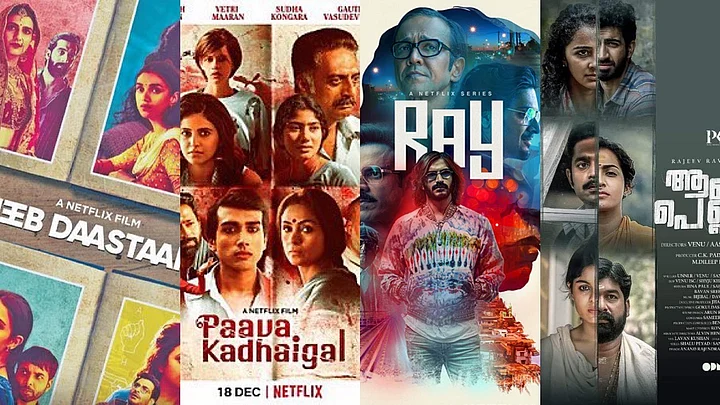In 2013, as a celebration of the centennial of Indian cinema, Bombay Talkies—a collection of four shorts depicting how intricately cinema is stitched into our lives—revived anthologies as a familiar medium. Anthologies, however, were not new to the Indian audience. They go back to the master, Satyajit Ray's literary genius. The year 2021, fittingly, is also the centenary year of Ray.
The many predecessors of Bombay Talkies—Dus Kahaniyaan (2007), Mumbai Cutting (2010), the Malayalam anthology Kerala Café (2009), the Telugu language drama Vedam (2010), and the efforts in the horror genre such as Darna Mana Hai (2003) and its sequel Darna Zaroori Hai (2006)—could not achieve what it did in terms of warming up the screens to the format. The grand theatrical release of the anthology, helmed by four big directors—Karan Johar, Zoya Akhtar, Dibakar Banerjee, and Anurag Kashyap—backed by the overwhelming idea of 100 years of Indian cinema, had an effect that was needed to familiarise anthologies. Although a risk at the time, it had the power of the mainstream and the gambles of alternate cinema.
Five years later, the same assemblage of filmmakers brought us Lust Stories, but this time on an OTT platform, and thus began the glorious saga of anthologies and online streaming. It marked the commencement of the now rampant anthology glut on OTT platforms.
The Pandemic Effect
The anthology fever peddled by OTT streaming sites could not have reached this piercing peak without the circumstantial assistance of the pandemic. Both, the production and the reception, were heavily altered since the beginning of 2020.
As far as production is concerned, short films were naturally a more practical and workable fair—shorter schedules, greater flexibility, smaller crew, greater control. With the economical disabilities that the pandemic brought with it, short-form content became the feasible option. It also turned out to be a favourable time for experimentation as the audience was receptive to different forms of storytelling now more than ever.
The more privileged pockets had a definite and a constant content crusade. Short form narratives had an effortless permeability across all platforms. It was reflective in the way even the independent short films garnered virality on the Internet. Anthologies were a great mix of versatility and freedom of choice, and frankly, just more convenient. In a world tormented by uncertainty, people found comfort in content that lacked commitment. Short films and anthologies, in my opinion, could make one of the most worthwhile profits off of the attention economy.
Another barrier that anthologies seemed to have blurred, especially during the pandemic, is that of the language. Tamil, Telugu, and Malayalam anthologies were equally anticipated and widely watched.
Malayalam anthology Aanum Pennum, Tamil anthology Paava Kadhaigal, and the Telugu language Pitta Kathalu, all stand as testament. Putham Pudhu Kaalai and Unpaused also adeptly roped in the theme of pandemic into their stories. Short-form content has encouraged people to opt for stories in languages that they may not speak.
Diving Into the Format
An enthusiast of short films and anthologies, I too cannot help but sniff at the excessively rising influx and the sharply falling effectiveness with each one. A format that allows experimentation and freedom is now unfortunately reduced to a loosely hanging thematic principle that cuts itself per convenience. The nature of an anthology is such that demands consistency. This uniformity comes with the advantage of unique voices and shades to the larger narrative. However, the detachment in the shorts is so apparent that it lends itself to comparison. Neeraj Ghaywan’s Geeli Pucchi stands out, miles away, in the otherwise jarringly desperate Ajeeb Daastaans. Zoya Akhtar’s short in Lust Stories and Banerjee’s in the subsequent Ghost Stories are easily more memorable than the rest. In Paava Kadhaigal, Sudha Kongara’s Thangam, a tale about a Muslim transgender woman, is the prominent one of the lot.
Dibakar Banerjee’s Star in Bombay Talkies, an adaptation of Satyajit Ray’s short story Patol Babu, Film Star, serves as an overachieving forerunner of the 2021 Netflix anthology Ray. Perhaps with the exception of Abhishek Chaubey's Hungama Kyon Hai Barpa that boasts of a stellar cast, the recent Netflix tribute to Satyajit Ray is an irreverent blend of inconsistency. The latest Feels like Ishq overcomes that gap only to be consistently mediocre. The thematic nexus of love seems so forced in some portions that one can visibly see them split up as individual episodes rather than a tight collection of stories.
The spirit of the anthology is compromised when the instalments add up to an imbalanced equation. The coming together of several filmmakers—that is initially so refreshing—alas, has burdened the recent Indian anthologies. These sincerely provide a peek into the truest pursuits of filmmaking of the directors—the commercial names too—devoid of the box-office pressures and gimmickry. Case in point: Karan Johar’s Ajeeb Dastaan Hai Yeh in Bombay Talkies. It tells a complex story of homosexuality that is radically different from Dharma Productions’ initial travesty in Dostana. But when this overshadows the final product, it fails the purpose of the format; an embodiment of too many cooks spoiling the broth.
Several projects such as Wild Tales, Easy, even Black Mirror for that matter, have been successful in holding together a competent anthological narrative. Bombay Talkies, one of the earlier endeavours, still remains an almost seamless effort among its future counterparts. It is tragic that the anthology format is suffering burnout in a land as diverse as ours. The format is not to blame. An anthology should be a melange of ideas and not a disintegrating train of thought; a balanced production and not a contest.
(At The Quint, we question everything. Play an active role in shaping our journalism by becoming a member today.)
